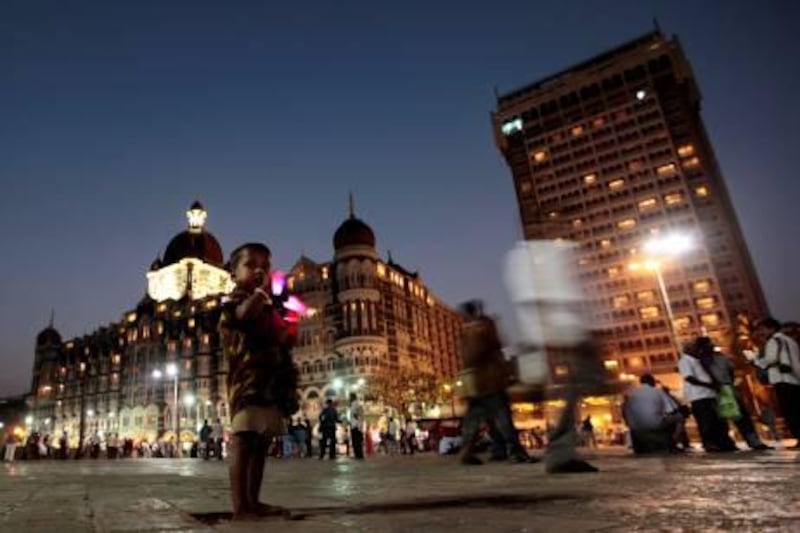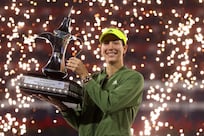I had been living in the south Mumbai neighbourhood of Colaba for months before I noticed a house on my street that likely served as an inspiration for Rohinton Mistry's novel A Fine Balance. Mistry's book chronicles the life of Dina Dalal née Shroff, a Parsi living in an unnamed city, quite obviously Mumbai. I was admiring Dina Lodge, a white five-storey 1930's mansion, when I noticed the family name Shroff on its gate.
In the book, Mistry describes the house's portico as "being bricked up and fitted with an iron-grilled window" to make an extra room, a practice common in space-hungry Mumbai. The iron-grilled windows remain, but today the house is in the midst of a renovation, its stained glass transoms restored, its Art Deco fixtures brought back to lustrous life and the porticos once again opened to the elements.
Of course, I can't confirm from the reclusive Mistry that the house was indeed his inspiration, but it's likely. Colaba is a Parsi stronghold and Mistry grew up a block away in Cusrow Baug, the Parsi housing colony that lies behind a behemoth gate on the thronged high street, Colaba Causeway.
Books and reading are thriving in Mumbai. Because Mumbai radiates with the romance that accompanies any big city that is a magnet for outsiders - be they Indians or colonials - the city has long been an inspiration to generations of writers. And unlike elsewhere in the world, the print media is still a growth industry, libraries busy and even the children hawking books in traffic jams are attuned to what the best-sellers are - these days they include a biography of the Indian industrialist Ambani family, anything by Dan Brown and another of Mistry's novels of Mumbai, Such A Long Journey. With this in mind, I set out from Colaba to catalogue some of Mumbai's other forgotten literary sites, including some that were hidden in plain sight, like Dina Lodge.
I quickly dismissed the landmarks from my favourite novel of Mumbai, Sacred Games, Vikram Chandra's epic story of the city's police and thieves. The book just covers too much ground, and visits to sites in the northern suburbs of Juhu and Bandra or the shabby sprawl and airport hotels of Santa Cruz would be rendered joyless by Mumbai's famous traffic. I also dismissed India's largest slum, Dharavi, in central Mumbai, which the Nobel prizewinner V S Naipaul described in India: A Million Mutinies Now as comprising "back-to-back and side-to-side shacks and shelters". Since the success of Slumdog Millionaire, tours of the slum are now available but that wasn't the kind of experience I was looking for on this day.
I decided to limit my search to the oldest part of the city, south Mumbai, which is manageable on foot. I set out north from touristy and residential Colaba, dodging the swarm of ancient black-and-yellow taxis as I crossed the busy streets, ignoring men selling giant balloons and bongo drums, and sidestepping the occasional cow. As I headed towards the Fort neighbourhood, south Mumbai's centre of commerce, I stopped briefly to look at the old Gothic sailor's home where Joseph Conrad stayed before boarding the Narcissus, which is now the state police headquarters. It made me think of Aldous Huxley, who wrote some of the first travel writing on India for western consumption. Huxley hated Bombay's Gothic buildings.
"Architecturally," he wrote in his 1926 travel memoir, Jesting Pilate, "Bombay is one of the most appalling cities of either hemisphere."
At least Huxley and I agree on the charm of the Town Hall Library on the east side of Horniman Circle in Fort. Huxley describes it as "long and low, with its flight of steps, its central pediment, its Doric colonnade, it has an air of calm and quiet decency. Among so many architectural cads and pretentious bounders, it's almost the only gentleman."
Today, Huxley's criticism seems rash, but seeing the neighbourhood through Huxley's eyes makes it possible to imagine a time when these antique buildings were new.
Town Hall Library is undergoing renovations, but the quiet decency Huxley described is still evident under the scaffolding. It is open, though, so I walked in. What I found was more akin to the ruin of a library or a museum of antique office furniture, except that it was buzzing with activity, readers cordoned off in the appropriate sections. Students studied at tables marked "Competative [sic] Examinations Reading Division", women read at "ladies only" tables and elderly men stood at drafting tables reading the city's various newspapers. The scene was presided over by a dust-coated statue of Mounstuart Elphinstone, Bombay's governor from 1819 to 1827.
The library had atmosphere in spades, but I found its stacks a bit lacklustre, comprising mainly outdated textbooks. The antidote to this is the pavement booksellers on the sidewalks near Fort's Flora Fountain, the Portland stone statue of the Roman goddess that is about a 10-minute walk from the library through a warren of narrow streets. The booksellers have thousands of books arrayed randomly, but they can pull obscure requests from the depths of their stalls. Prices are negotiable and start at about 400 Indian rupees (Dh33) for new titles and 200 rupees (Dh16) for old books.
Another advantage of the Fort bookstalls, I discovered, is their proximity to Mumbai's famous street snacks. In his Pulitzer Prize-nominated book of reportage on Mumbai, Maximum City, the Bombay-bred Suketu Mehta calls Mumbai a "vadapav eaters' city", referring to the potato fritter sandwiches served on buns called pav (pronounced "pow") that are "the lunch of the chawl [slum] dwellers, the cart pullers, the street urchins, the cops and the gangsters". My favourite pav are sold by vendors in front of St Xavier's College in Fort, the difference being the freshness and the variety of chutneys. Sure enough, the snack stalls were thronged with students, office workers and labourers to whom an afternoon snack is serious business. And at eight rupees (Dh0.6) per sandwich, it's the closest you'll come to a free lunch.
My mouth still tingling from spicy chutney, I headed a few blocks south down Mohandas Gandhi Road, one of south Mumbai's main north-south arteries, to my favourite Mumbai building, the Esplanade Mansion, the site of the old Watson's Hotel, which was the swankiest address in town 100 years ago. It was the first building constructed here with a cast iron frame, parts of which are still visible beneath the ad hoc additions. I had read Mark Twain's account of Bombay in his 1897 travelogue, Following the Equator and found particularly memorable his passage on staying at Watson's, and his description of the German manager's treatment of the servants and how it reminded him of American slavery. Likewise his account of how he was set upon by that still-too-present scourge, the Indian crow.
In ruins, the hotel is a thorn in the side of preservationists. The Italian architect Renzo Piano has advocated restoration of the building and it has been placed on the World Monuments Fund's watch list, but renovations have stalled. When I walked into the building I found it to be a functioning hub for the city's solicitors, its 130 guest rooms now lawyer's offices, the exception being an old man working at a sewing machine on one of the landings. The hotel's central courtyard looked like a bomb had gone off there, but the building's majesty was still evident in its yellow and black tile floors, and its grand staircases with wrought iron balustrades. Again, it took looking at the building through Twain's lens to recognise what an impressive building it once was and could be again.
Next, I decided to head a little further afield and visit one of my favourite areas of Mumbai, Chor Bazaar, or the "thieves market", about 15 minutes to the north by taxi, traffic permitting. On my way, though, I thought I'd seek out one more spot from colonial times, so I instructed my driver to pull over in front of the JJ Arts school near the imposing and impressive Chhatrapati Shivaji Terminus (formerly Victoria Terminus) train station so I could look for the site of Rudyard Kipling's birth in 1865. Kipling's father was a professor at the school and, sure enough, tucked away in a forgotten corner of the campus stands a green wooden bungalow said to be the one Kipling grew up in. In fact, the current bungalow was built long after Rudyard Kipling was sent to school in England at the age of five, but under its veranda is an obelisk commemorating the author's birth along with a bust of the man himself, his bald pate splattered with bird droppings, perhaps a metaphor for Kipling's standing here these days.
With not much else to see, I hopped back in the cab and headed north to the Bohra Muslim neighbourhood that is home to Chor Bazaar. I'd been a half-dozen times, but had just been reading about it in The Lost Flamingoes of Bombay, the Man Asian Prize short-listed novel by another Mumbai native, Siddharth Dhanvant Shanghvi, and I had a hankering to go back. The market is actually a neighbourhood of shops selling anything from antiques and furniture to old mobile phones and car parts.
When I contacted Shanghvi, he told my why he keeps going back to Chor Bazaar.
"It has such a wonderful mood of romance," he said. "Just the other day I saw a wooden palanquin for sale. Upon inquiry, I learnt it was originally owned by a princess from north India. The owner also discreetly offered to give me a discount of 20 per cent. When I said I didn't generally like to go about Bombay in a palanquin, he said, 'You should try it.' He then said he would remake me the same piece for half the price and throw in a distressed finish to resemble the original."
With my purchases - some old 45-rpm records, a postcard of the Bollywood icon Amitabh Bachchan, a spatula and some rasgulla, a milky Indian sweet - I headed back to Colaba to unwind with a bottle of something cold and a plate of chicken reshmi kebabs at another contemporary literary setting, Leopold Café, a favourite meeting spot for modern Indians and dreadlocked backpackers alike. Leopold was a favourite haunt for the characters in the Australian Gregory David Robert's mafia epic Shantaram. In fact, Shantaram is sold there and it's even quite possible to see Roberts, who lives here now, holding court, distinguished by his barrel chest and flowing mullet. Roberts, in fact, was keen to use all of Mumbai's iconic landmarks in his novel - the Taj Mahal Palace Hotel, the Gateway of India, Flora Fountain - and it's one reason why the novel resonates with people who have spent time here.
All of the world's great cities have a turn as a literary hotspot and Mumbai seems to be having its turn now. After the international success of Maximum City, publishers are greedy for new books about Mumbai, and bookstore shelves here are crammed with new titles set in the city. Because of this, visiting Mumbai's literary sites seems somehow relevant, rather than a simple exercise in nostalgia. As Shanghvi told me, the city is an apt canvas for all this pent-up literary energy. "Salman Rushdie, Suketu Mehta, Rohinton Mistry are all fine storytellers of this city, and their work is profoundly influenced by the landscape. Simply put, they can write about anything, but it is Bombay that tells their story best."
If you go
The flight Return flights on Etihad Airways (www.etihadairways.com) from Abu Dhabi to Mumbai cost from Dh1,505, including taxes
The stay Double rooms at the Ascot Hotel in Colaba (www.ascothotel.com; 00 91 22 6638 5566), housed in a fine Art Deco building, cost from 6,600 rupees (Dh548), including taxes. Nearby in Colaba is the more posh Gordon House (www.ghhotel.com; 00 91 22 2289 4400), which offers Mediterranean and Scandinavian-style rooms. A double room starts at 12,000 rupees (Dh994), including taxes
The read South Mumbai is easily navigable by taxi. Make sure the driver uses the meter rather than negotiate a higher rate. A good guide to its landmarks and old buildings is Fort Walks by Sharada Dwivedi and Rahul Mehrotra. A great space to browse for this and other titles is Search Word bookstore (Shop No 7, Metro House, Colaba Causeway;
00 91 22 2285 2521)










